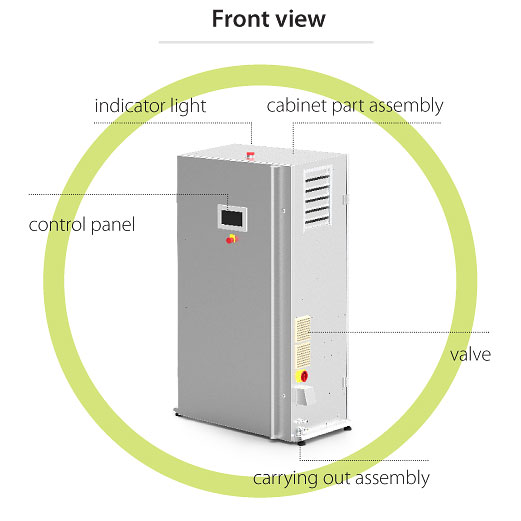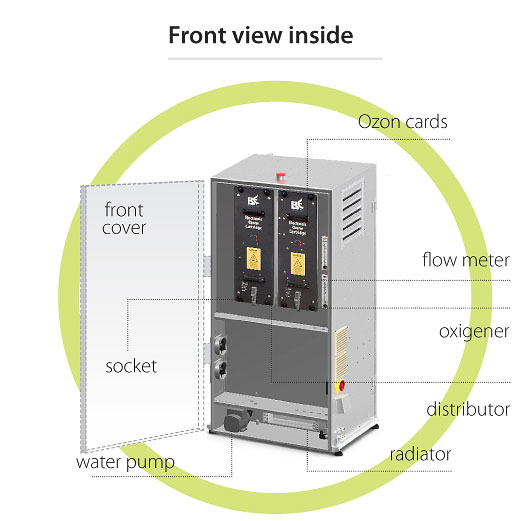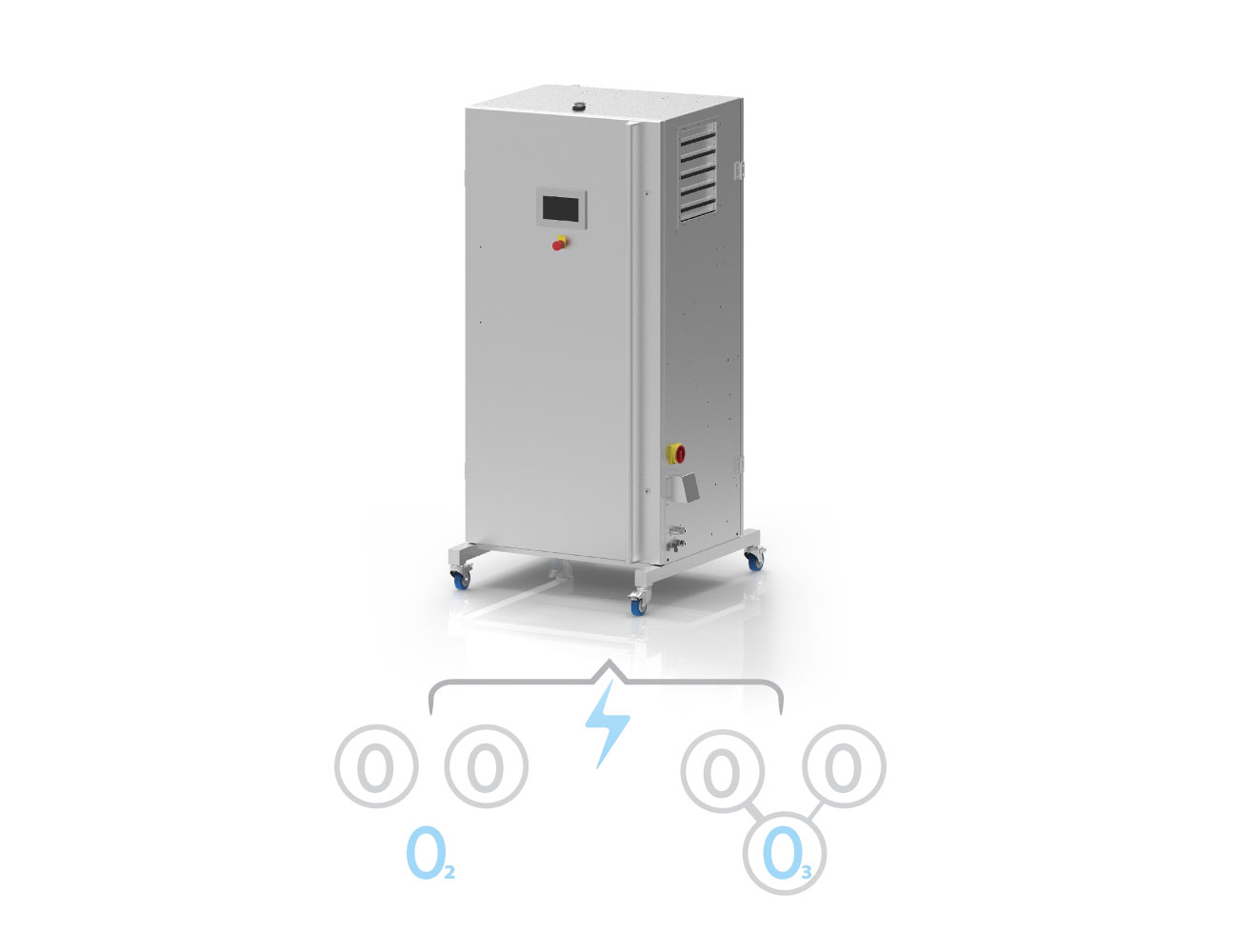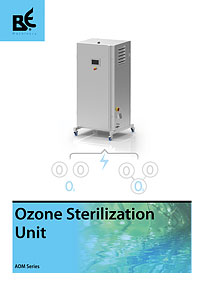Ozone Unit
Ozone Package Sterilisation UnitThe Principle Function:
The markets has an increasing demand to fruits, vegetables and salads clean of any contamination from pathogens and chemical contaminants or detergents.
Ozonized water is used in a variety of operations to wash fruits and vegetables including ready to eat salad products.
As mentioned, Ozone is a more powerful disinfectant than Hydrogen Peroxide, chlorine, chlorine dioxide and many of the industry disinfectant agents. As said Ozone effective against an Extremely wide range of pathogens .
Ozone is said to be about 50% more powerful and to act 3,000 times faster than chlorine at 100 times the strength.
What is OZONE and how is it produced?
Ozone, or trioxygen, is a fast-acting oxidizing disinfectant made up of three oxygen atoms (O3). Ozone occurs naturally in the upper atmosphere, or stratosphere, when the sun’s light splits oxygen molecules (O2) into separate atoms. When these single atoms bond with other oxygen molecules, they form ozone, protecting us from the sun’s harmful ultraviolet rays.
The word “ozone” comes from the Greek “ozein” meaning “to smell”, and was discovered by a Swiss-German chemist and professor at the University of Basel (Switzerland) Christian Shönbein. Shönbein identified it as a different form of oxygen and gave it the name Ozone in 1840, because of the peculiar smell that it produces, such as what occurs during storms.
System View:


Historical Uses of OZONE
| Year | Event |
|---|---|
| 1840 | Ozone is discovered by Christian Shönbein. |
| 1910 | First use of ozone for the preservation of frozen meat in Germany. |
| 1936 | Ozone began being used to wash and protect fish in the commercial seafood industry in France. |
| 1942 | Ozone used to protect dairy products while in storage, such as eggs and cheese in the United States. |
| 1957 | Ozone in the gaseous form was approved for the storage of meat by the USDA. |
| 1977 | treatment used to fight Salmonella bacteria, a major cause of food poisoning, from contaminating eggs in Russia. |
| 1982 | Ozone approved by the FDA (Food and Drug Administration) as GRAS (Generally Recognized as Safe) for bottled water in the United States. |
| 1995 | FDA reaffirms GRAS declaration for bottled water. |
| 1997 | A panel of experts determined, thanks to the efforts of the Research Institute of Electric Power Industry and Food, that ozone could be declared GRAS for food processing in the United States. |
| 2001 | Ozone receives FDA recognition as a direct food additive second class. |
| 2001 | FSIS (Food Safety and Inspection Services) determines that ozone is safe for use in meat and poultry. |
Advantages of Ozone
- The most potent oxidizing disinfectant to decontaminate water and sanitize surfaces
- Ozone is the toughest microbiological control agent
- Kills pathogens faster than any other commercially available oxidizing agent
- Naturally decomposes back into oxygen
- Safe for the environment leaving no toxic residue
- Ozone does not affect Ph levels on it’s own
- Improves filtration by enhancing the coagulation and flocculation (bringing smaller particles together to form flocs) of organic material
- Assists biological filters by partially oxidizing organics into biodegradable compounds that are easier to remove from water
- Oxidizes metals such as iron, manganese, and more
- Ozone is a highly reactive compound produced from the oxygen in the air. It is not possible to store it, and there is no need, making bulky hazardous containers unnecessary.
Ozone destroys all molds, viruses and bacteria common in the food industry:
• Aspergillus Niger (Black Mount), Destroyed by 1.5 to 2 mg/I • Bacillus Bacteria, Destroyed by 0.2 m/I within 30 seconds • Bacillus Anthracis, Ozone susceptible • Bacillus Cereus, 99% destruction after 5 min at 0.12 mg/l in water • B. Cereus (Spores), 99% destruction after 5 min at 2.3 mg/l in water • Bacillus Subtilis, 90% reduction at 0.10 PPM for 33 minutes • Bacteriophage f2, 99.99% destruction at 0.41 mg/l for 10 seconds in water • Botrytis Cinerea, 3.8 mg/l for 2 minutes • Candida Bacteria, Ozone susceptible • Clavibacter michiganense, 99.99% destruction at 1.1 mg/l for 5 minutes • Cladosporium, 90% reduciton at 0.10-PPM for 12.1 minutes • Clostridium Bacteria, Ozone susceptible • Clostridium Botulinum (Spores), 0.4 to 0.5 mg/l threshold value • Coxsackie Virus A9, 95% destruciton at 0.035 mg/l for 10 seconds in water • Coxsackie Virus B5, 99.99% desctruction at 0.4 mg/l for 2.5 minutes in sludge effluent • Diphtheria Pathogen, Destroyed by 1.5 to 2 mg/l • Eberth Bacillus (Typhus Abdomanalis), Destroyed by 1.5 to 2 mg/l • Echo Virus 29: The virus most sensitive to ozone. After a contact time of 1 minute at 1 mg/l of ozone, 99.999% killed • Enteric Virus, 95% destruction at 4.1 mg/l for 29 minutes in raw wastewater • Escherichia Coli Bacteria (from feces), Destroyed by 0.2 mg/l within 30 seconds in air • E-coli (in clean water), 99.99% destruction at 0.25 mg/l for 1.6 minutes • Encephalomyocarditis Virus, Destroyed to zero level in less than 30 seconds with 0.1 to 0.8 mg/l • Endamoebic Cysts Bacteria, Ozone susceptible • Enterovirus Virus, Destoryed to zero level in less than 30 seconds with 0.1 to 0.8 mg/l • Fusarium Oxysporium f sp. Lycopersici, 1.1 mg/l for 10 minutes • Fusarium Oxysporium f sp. Melonogea, 99.99% destruction at 1.1 mg/l for 20 minutes • GDVII Virus, Destroyed to zero level in less than 30 seconds with 0.1 to 0.8 mg/l • Hepatitus A Virus, 99.5% reduction at 0.25 mg/l for 2-seconds in a phosphate buffe • Herpes Virus, Destroyed to zero level in less than 30 seconds with 0.1 to 0.8 mg/l • Influenza Virus, 0.4 to 0.5 mg/l threshold value • Klebs-Loffler Bacillus, Destroyed by 1.5 to 2 mg/ • Legionella Pneumophila, 99.99% destruciton at 0.32 mg/l for 20 minutes in distilled water • Luminescent Basidiomycetes, Destroyed in 10 minutes at 100-PPM • Mucor Piriformis, 3.8 mg/l for 2 minutes • Mycobacterium Avium, 99.9% with a CT value of 0.17 in water • Mycobacterium Foruitum, 90% destruction at 0.25 mg/l for 1.6 minutes in water • Penicillium Bacteria, Ozone susceptible • Phytophthora Parasitica, 3.8 mg/l for 2 minutes • Poliomyelitis Virus, 99.99% kill with 0.3 to 0.4 mg/l in 3-4 minutes • Poliovirus Type 1, 99.5% destruction at 0.25 mg/l for 1.6 minutes in water • Proteus Bacteria, Very susceptible • Pseudomonas Bacteria, Very susceptible • Rhabdovirus virus, Destroyed to zero level in less than 30 seconds with 0.1 to 0.8 mg/l • Salmonella Bacteria, Very susceptible • Salmonella typhimurium, 99.99% destruction at 0.25 mg/l for 1.67 minutes in water • Schistosoma Bacteria, Very susceptible • Staph epidermidis, 90% reduction at 0.1-ppm for 1.7 min • Staphylococci, Destroyed by 1.5 to 2.0 mg/l • Stomatitis Virus, Destroyed to zero level in less than 30 seconds with 0.1 to 0.8 mg/l • Streptococcus Bacteria, Destroyed by 0.2 mg/l within 30 seconds • Verticillium dahliae, 99.99 % destruction at 1.1 mg/l for 20 minutes • Vesicular Virus, Destroyed to zero level in less than 30 seconds with 0.1 to 0.8 mg/l • Virbrio Cholera Bacteria, Very susceptible • Vicia Faba progeny, Ozone causes chromosome aberration and its effect is twice that observed by the action of X-rays
Source: Ozone cip project – Study of ozone technology, public report
 English
English Русский
Русский


